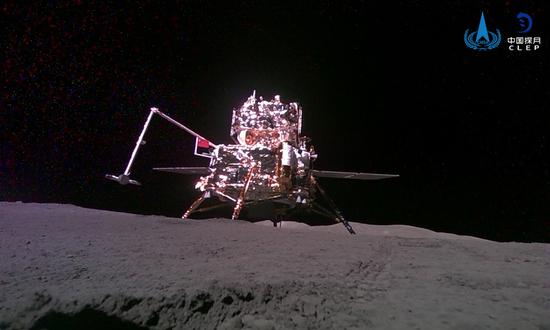Queqiao-2 relay satellite achieves 'multiple firsts' in scientific explorations

A picture taken by a mobile camera shows the Chang’e-6 lunar probe’s lander and ascender vehicles on the surface of far side of the moon on June 3, 2024. (Photo/Courtesy of the CNSA)
As part of China’s moon probe project, the Queqiao-2 relay satellite has completed a series of scientific explorations for the first time with its onboard payloads, the China Lunar Exploration Project (CLEP) said on its official WeChat account on Monday.
According to CLEP, phased progress in scientific research with the Queqiao-2 has been made as the onboard payloads completed in-orbit testing and carried out various scientific explorations.
The relay satellite has been operating in orbit for 14 months since it was sent into space. After completing in-orbit testing, the three onboard payloads have carried out scientific explorations, including large-scale imaging and observations of the Earth’s plasmasphere and magnetosphere, as well as the very long baseline interferometry (VLBI) experimental observations of the Earth-moon system.
The extreme ultraviolet camera, one of the three payloads, captured the world’s first panoramic image of the ionosphere at 83.4-nanometer wavelength, providing valuable observational data for studies, including the impact of solar activity on the plasmasphere.
The arrayed neutral atom imager obtained high-resolution images of energetic neutral atoms in the magnetosphere, especially during quiet geomagnetic periods, geomagnetic storms and magnetospheric substorms. The images provide firsthand observational data for studying changes in energetic particles in the Earth’s magnetosphere under different solar activity conditions.
The joint Earth-moon observations carried out by the VLBI experiment system and the ground stations such as the Shanghai 65-meter Radio Telescope (Tianma Telescope) have for the first time extended the observation distance to 380,000 kilometers, which successfully observed deep-space targets such as the Chang’e-6 probe and significantly improved observation accuracy.
From May to June 2024, the Queqiao-2 provided stable and reliable relay communication services for human beings’ first sample collection from the far side of the moon as part of the Chang’e-6 lunar mission.
Apart from continuing scientific explorations, the relay satellite will also offer relay communication services for upcoming lunar probe missions from both China and other countries in the future.
